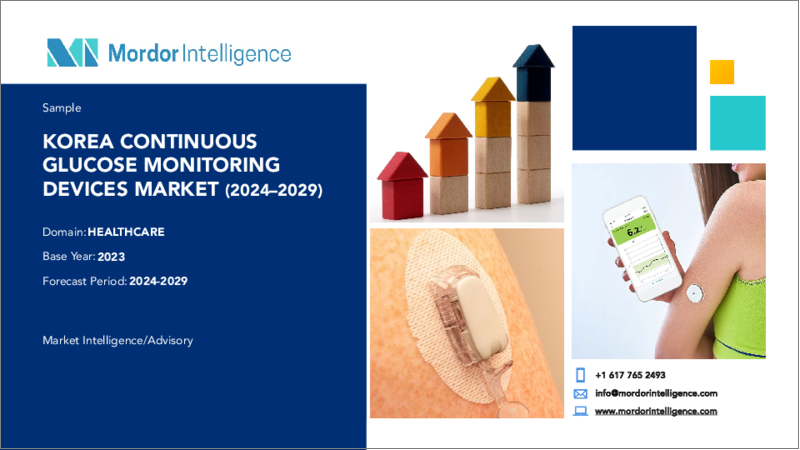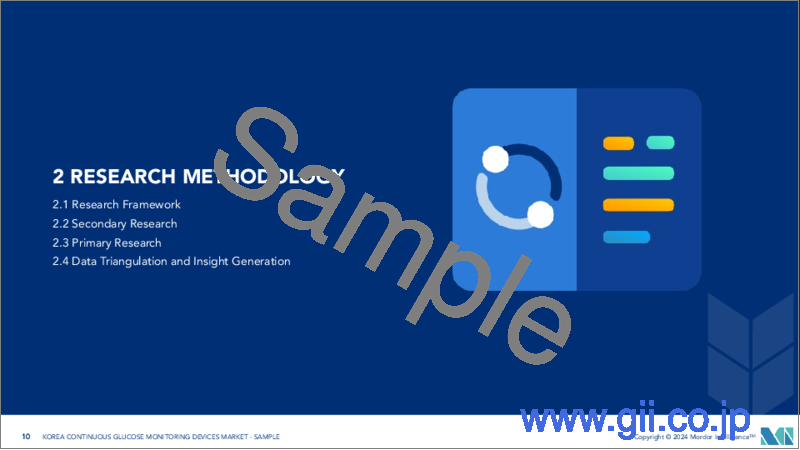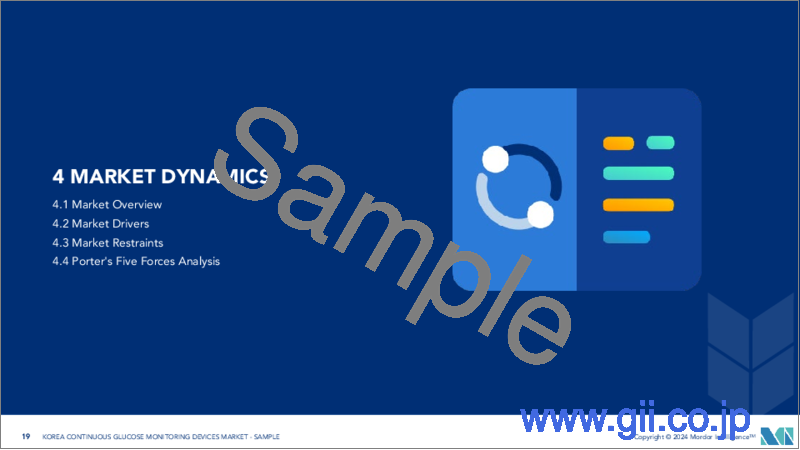|
|
市場調査レポート
商品コード
1408180
韓国の持続グルコースモニタリング機器:市場シェア分析、産業動向&統計、2024~2029年成長予測Korea Continuous Glucose Monitoring Devices - Market Share Analysis, Industry Trends & Statistics, Growth Forecasts 2024 - 2029 |
||||||
カスタマイズ可能
適宜更新あり
|
|||||||
| 韓国の持続グルコースモニタリング機器:市場シェア分析、産業動向&統計、2024~2029年成長予測 |
|
出版日: 2024年01月04日
発行: Mordor Intelligence
ページ情報: 英文 70 Pages
納期: 2~3営業日
|
全表示
- 概要
- 目次
韓国の持続グルコースモニタリング機器市場規模は、2024年に842億4,000万米ドルと推計され、2029年には1,320億米ドルに達すると予測され、予測期間中(2024~2029年)のCAGRは9.40%で成長する見込みです。
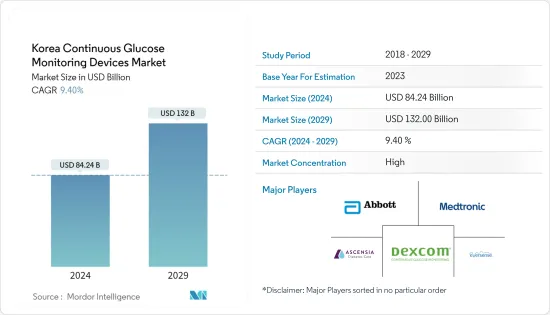
糖尿病は、COVID-19患者の死亡リスクや重篤な臨床転帰に密接に関連する主な併存疾患のひとつです。数多くの疫学的知見から、重篤な臨床経過をたどるCOVID-19患者では糖尿病の割合が高く、糖尿病患者は糖尿病のない患者よりもCOVID-19感染に対して脆弱であることが一貫して示唆されていました。
パンデミックの間、医療提供者や糖尿病患者は接触を最小限にし隔離することが求められ、遠隔医療は急性合併症の予防と重症高血糖のコントロールにおいて代替支援を提供しました。SARS-CoV-2に感染していない糖尿病患者も、COVID-19の一次予防の一環として、最適な血糖コントロールを維持することが推奨されました。
CGMSの主な使用対象は、インスリン治療を受けている1型または重症の2型糖尿病患者です。インスリン依存型糖尿病患者がSBGMに依存する場合、1日に10回まで針で指を刺して採血し、血糖値を測定し、状況によってはインスリンを注射して高血糖ショックや低血糖ショックを避ける必要があります。一方、CGMSのユーザーは、1回のセンサー挿入で1~7日間、追加の採血なしに血糖値の変化をモニターすることができます。
市場調査を推進する主な要因は、糖尿病有病率の増加と韓国政府による支援イニシアティブです。
韓国の持続グルコースモニタリング機器市場動向
予測期間中、耐久消費財セグメントが最も高い成長率を示す見込み
センサーのトランスミッターは、血糖測定値をリーダー、レシーバー、またはスマートフォンアプリに通信するものです。受信機として知られるデバイスは、送信機からデータを収集し、その結果をさまざまなユーザーインターフェースに表示するものです。メーカーによると、さまざまなCGMデバイスのコンポーネントの動作は異なります。これらのガジェットは皮膚に貼る必要があり、目に見えることもあります。トランスミッターのバッテリーは、使い捨てタイプと充電式タイプの両方があります。糖尿病患者におけるCGM装置の使用率の上昇、糖尿病の根本的な原因の増加、市場での製品の入手可能性、これらの耐久消費財の利点、日本の消費者のCGM装置使用に対する意識の高まりの結果、市場分野は拡大すると予想されます。
韓国のNHISは、韓国政府が管理する単一の強制健康保険制度であり、韓国のほぼ全人口にヘルスケアを提供しています。韓国のNHISデータベースには、社会人口統計学的情報、医療サービスの利用、医療請求、健康診断が含まれています。韓国人は、消耗品であれCGMSであれ、保険の割り戻しを要求する前に、NHISに1型糖尿病患者として登録しなければならないです。患者は、1日か2日後にNHIコールセンターに電話すれば確認できるだけであるが、患者の主治医が代わりに行ってくれます。CGM耐久消費財の払い戻しを申請するには、韓国人は薬価払い戻し申請書、処方箋、現金領収書、取引明細書が必要でした。
糖尿病の有病率の増加や、公的機関や民間団体によるイニシアチブの増加などの要因が、予測期間中に同国の市場成長を増加させると予想されます。
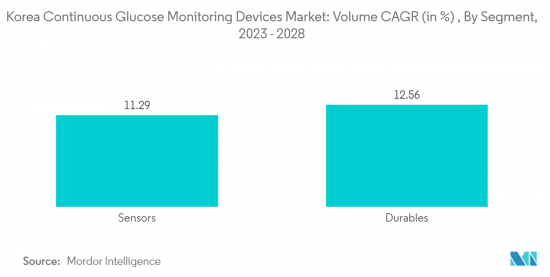
糖尿病有病率の上昇
韓国の1型糖尿病人口は、予測期間中にCAGR 0.35%以上で増加すると予想されます。
1型糖尿病と2型糖尿病はどちらも、血液中のグルコース(糖)濃度が高いことを特徴とする慢性疾患です。しかし、両者はその原因、症状、危険因子が異なります。1型糖尿病は、インスリン依存性糖尿病としても知られ、膵臓のインスリン産生細胞に対する自己免疫攻撃によって引き起こされ、インスリン産生が完全に欠如します。通常、小児期または成人期早期に発症し、管理には毎日のインスリン注射が必要です。一方、2型糖尿病は、インスリン抵抗性(体がインスリンを効果的に使えない状態)とインスリン産生の減少が組み合わさって起こります。通常、食生活の乱れ、運動不足、肥満などの生活習慣と関連しており、成人に多くみられます。食事療法や運動療法などの生活習慣の改善によって管理できることが多いのですが、2型糖尿病患者の中には薬物療法やインスリン療法が必要な人もいます。どちらのタイプの糖尿病も、適切に管理されなければ深刻な健康合併症を引き起こす可能性があります。
2022年1月、韓国の医療機器市場規制当局である食品医薬品安全部(MFDS)は、韓国の医療機器法のいくつかの改正を展開する予定であり、電子的な使用適応の対象となる機器のリストも拡大しました。韓国市場における遠隔患者モニタリング機器の普及は、現地の臨床研究機関(CRO)の臨床研究試験を支援し、モニタリングの容易さを保証することで、発見プロセスを促進します。
糖尿病は韓国で最も蔓延している慢性疾患の一つです。したがって、糖尿病の有病率の増加は、同国における持続的グルコースモニタリングの採用を増加させ、予測期間中の市場成長を増加させると予想されます。
韓国の持続グルコースモニタリング機器産業概観
韓国の持続グルコースモニタリング機器市場は高度に統合されています。Dexcom社、Abbott社、Medtronic社などの市場リーダーは、市場での足場を固めるため、製品の発売や技術提携に注力しています。
その他の特典:
- エクセル形式の市場予測(ME)シート
- 3ヶ月間のアナリストサポート
目次
第1章 イントロダクション
- 調査の前提条件と市場定義
- 調査範囲
第2章 調査手法
第3章 エグゼクティブサマリー
第4章 市場力学
- 市場概要
- 市場力学
- 市場促進要因
- 市場抑制要因
- 業界の魅力- ファイブフォース分析
- 供給企業の交渉力
- 消費者の交渉力
- 新規参入業者の脅威
- 代替品の脅威
- 競争企業間の敵対関係の強さ
第5章 市場セグメンテーション
- コンポーネント別
- センサー
- 耐久消費財(レシーバーとトランスミッター)
- CGMデバイスユーザー
- ソウル
- 釜山広域市
- 大邱広域市
- 仁川広域市
- 光州広域市
- 大田広域市
- 蔚山広域市
- 世宗特別自治市
- 京畿道
- 江原道
- 忠清北道
- 忠清南道
- 全羅北道
- 全羅南道
- 慶尚北道
- 慶尚南道
- 特別自治道
- 道別
- ソウル
- 釜山広域市
- 大邱広域市
- 仁川広域市
- 光州広域市
- 大田広域市
- 蔚山広域市
- 世宗特別自治市
- 京畿道
- 江原道
- 忠清北道
- 忠清南道
- 全羅北道
- 全羅南道
- 慶尚北道
- 慶尚南道
- 特別自治道
- 官民別市場シェア
- CGM機器の流通経路の分析(病院、診療所、薬局、その他の形態のシェア比率を含む)
- CGMデバイスの処方者の分析(内分泌専門医、糖尿病専門医、その他のHCPの専門分野、CGMデバイスの処方者の知識のシェアを含む)
第6章 市場指標
- 1型糖尿病人口
- 2型糖尿病人口
第7章 競合情勢
- 企業プロファイル
- Abbott Diabetes Care Inc.
- Dexcom Inc.
- Medtronic PLC
- Eversense
- Ascensia
- 企業シェア分析
- Abbott Diabetes Care Inc.
- Dexcom Inc.
- Medtronic PLC
- その他の企業
第8章 市場機会と今後の動向

The Korea Continuous Glucose Monitoring Devices Market size is estimated at USD 84.24 billion in 2024, and is expected to reach USD 132 billion by 2029, growing at a CAGR of 9.40% during the forecast period (2024-2029).
Diabetes was one of the main comorbidities closely related to the risk of mortality and severe clinical outcomes in patients with COVID-19. Numerous epidemiological findings consistently suggested that the proportion of diabetes was higher in COVID-19 patients with a severe clinical course and that people with diabetes were also more vulnerable to COVID-19 infection than those without diabetes.
During the pandemic, health providers or diabetic patients were required to minimize contact and quarantine, and telehealth provided alternative support in preventing acute complications and controlling severe hyperglycemia. People with diabetes who were not infected with the SARS-CoV-2 were also recommended to maintain optimal glycemic control as part of the primary prevention of COVID-19.
The primary use of CGMS is for patients with type 1 or severe type 2 diabetes who are on insulin therapy. If insulin-dependent diabetics are dependent on SBGM, they should prick their fingers with needles up to 10 times a day to draw blood to measure blood glucose and, depending on the situation, inject insulin to avoid hyperglycemic or hypoglycemic shock. On the other hand, CGMS users can monitor their blood glucose changes for 1-7 days without any additional blood draw with a single sensor insertion.
The key factors propelling the market studied are increasing diabetes prevalence and the support initiatives taken by the Korean government.
Korea Continuous Glucose Monitoring Devices Market Trends
The Durables Segment is Expected to Witness the Highest Growth Rate Over the Forecast Period
A sensor's transmitter is what communicates blood glucose readings to a reader, receiver, or smartphone app. Devices known as receivers are those that collect data from transmitters and present the results on various user interfaces. According to the manufacturer, various CGM device components operate differently. These gadgets may need to be applied to the skin and are sometimes visible. Both disposable and rechargeable transmitter batteries are available. The market sector is anticipated to expand as a result of rising CGM device usage among diabetics, rising underlying causes of diabetes, market product availability, benefits of these durables, and increased awareness of CGM device use among Japanese consumers.
Korean NHIS is a single, compulsory health insurance system managed by the Korean government, providing healthcare coverage to almost the entire Korean population. The Korean NHIS database includes sociodemographic information, the use of medical services, medical claims, and health examinations. Koreans must register with NHIS as Type 1 Diabetics before requesting any insurance rebates, whether for consumables or CGMS. The patient can simply confirm this a day or two later by calling the NHI call center, but the patient's doctor will be able to do that for them. In order to apply for a refund for CGM Durables, Koreans needed an NHI refund form, prescription, cash receipt, and transaction statement.
Factors such as the increasing prevalence of diabetes, coupled with the increasing initiatives by public and private organizations, are expected to increase market growth in the country over the forecast period.

Rising Prevalence of Diabetes
The Type 1 diabetes population in Korea is expected to increase at a CAGR greater than 0.35% over the forecast period.
Type 1 diabetes and Type 2 diabetes are both chronic diseases characterized by high levels of glucose (sugar) in the blood. However, they differ in their causes, symptoms, and risk factors. Type 1 diabetes, also known as insulin-dependent diabetes, is caused by an autoimmune attack on the insulin-producing cells in the pancreas, leading to a complete lack of insulin production. It typically develops in childhood or early adulthood and requires daily injections of insulin to manage. Type 2 diabetes, on the other hand, is caused by insulin resistance (when the body can't effectively use insulin) combined with a decrease in insulin production. It is usually linked to lifestyle factors such as poor diet, lack of physical activity, and obesity and is more common in adults. It can often be managed through lifestyle changes such as diet and exercise, although some people with type 2 diabetes may also need medication or insulin therapy. Both types of diabetes can lead to serious health complications if not properly managed.
In January 2022, the Ministry of Food and Drug Safety (MFDS), South Korea's medical device market regulator, planned to roll out several amendments to the country's Medical Devices Act and has also expanded its list of devices eligible for electronic indications for use. Penetration of remote patient monitoring devices in the South Korean market supports local clinical research organizations (CROs) in their clinical research trials and ensures ease of monitoring, which facilitates the discovery process.
Diabetes is one of the country's most prevalent chronic diseases. Thus, the increasing prevalence of diabetes is expected to increase the adoption of continuous glucose monitoring in the country, which is expected to increase market growth over the forecast period.
Korea Continuous Glucose Monitoring Devices Industry Overview
The Korean continuous glucose monitoring devices market is highly consolidated. Market leaders such as Dexcom, Abbott, and Medtronic are focusing on product launches and technological collaborations to increase their foothold in the market.
Additional Benefits:
- The market estimate (ME) sheet in Excel format
- 3 months of analyst support
TABLE OF CONTENTS
1 INTRODUCTION
- 1.1 Study Assumptions and Market Definition
- 1.2 Scope of the Study
2 RESEARCH METHODOLOGY
3 EXECUTIVE SUMMARY
4 MARKET DYNAMICS
- 4.1 Market Overview
- 4.2 Market Dynamics
- 4.2.1 Market Drivers
- 4.2.2 Market Restraints
- 4.3 Industry Attractiveness - Porter's Five Forces
- 4.3.1 Bargaining Power of Suppliers
- 4.3.2 Bargaining Power of Consumers
- 4.3.3 Threat of New Entrants
- 4.3.4 Threat of Substitute Products and Services
- 4.3.5 Intensity of Competitive Rivalry
5 Market Segmentation
- 5.1 By Component
- 5.1.1 Sensors
- 5.1.2 Durables (Receivers and Transmitters)
- 5.2 CGM Device Users
- 5.2.1 Seoul
- 5.2.2 Busan
- 5.2.3 Daegu Metropolitan City
- 5.2.4 Incheon Metropolitan City
- 5.2.5 Gwangju
- 5.2.6 Daejeon
- 5.2.7 Ulsan Metropolitan City
- 5.2.8 Sejong Special Self-Governing City
- 5.2.9 Gyeonggi-do
- 5.2.10 Gangwon-do
- 5.2.11 Chung-cheong bukdo
- 5.2.12 Chungcheongnam-do
- 5.2.13 Jeollabuk do
- 5.2.14 Jeollanam-do
- 5.2.15 Gyeongsangbuk-do
- 5.2.16 Gyeongsangnam-do
- 5.2.17 Special Self-governing Province
- 5.3 By Provinces
- 5.3.1 Seoul
- 5.3.2 Busan
- 5.3.3 Daegu Metropolitan City
- 5.3.4 Incheon Metropolitan City
- 5.3.5 Gwangju
- 5.3.6 Daejeon
- 5.3.7 Ulsan Metropolitan City
- 5.3.8 Sejong Special Self-Governing City
- 5.3.9 Gyeonggi-do
- 5.3.10 Gangwon-do
- 5.3.11 Chung-cheong bukdo
- 5.3.12 Chungcheongnam-do
- 5.3.13 Jeollabuk do
- 5.3.14 Jeollanam-do
- 5.3.15 Gyeongsangbuk-do
- 5.3.16 Gyeongsangnam-do
- 5.3.17 Special Self-governing Province
- 5.4 Market Share by Public and Private
- 5.5 Analysis of CGM Device Distribution Channels (Includes Percentage Share of Hospitals, Clinics, Pharmacies, and Other Modes)
- 5.6 Analysis of CGM Device Prescribers (Includes Percentage Share of Endocrinologists, Diabetologists, Other HCP Specialties, and Prescribers Knowledge of CGM Devices)
6 Market Indicators
- 6.1 Type-1 Diabetes Population
- 6.2 Type-2 Diabetes Population
7 COMPETITIVE LANDSCAPE
- 7.1 Company Profiles
- 7.1.1 Abbott Diabetes Care Inc.
- 7.1.2 Dexcom Inc.
- 7.1.3 Medtronic PLC
- 7.1.4 Eversense
- 7.1.5 Ascensia
- 7.2 Company Share Analysis
- 7.2.1 Abbott Diabetes Care Inc.
- 7.2.2 Dexcom Inc.
- 7.2.3 Medtronic PLC
- 7.2.4 Other Companies
